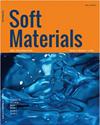铁电纳米分散胆甾液晶的结构转变
IF 1.4
4区 材料科学
Q4 MATERIALS SCIENCE, MULTIDISCIPLINARY
引用次数: 0
摘要
摘要:本文从理论上研究了分散在铁电纳米颗粒中的胆甾液晶的取向和电学行为。我们假设在液晶分子和纳米颗粒之间存在一种软平面耦合。研究了外加电场作用下铁电纳米分散体系中的两种螺旋结构。这种假设是由于指向性和偏振矢量具有不同螺距的螺旋结构。我们研究了平均极化和螺旋结构的螺距随场强的变化规律。通过计算临界电场,研究了铁电纳米颗粒对胆固醇-向列相转变的影响。讨论了场强和材料参数对相变的影响。计算是基于发展的连续统理论和螺旋超分子结构的自由能的修正形式。研究了纳米颗粒体积分数对两种螺旋结构的螺旋展开的影响。研究发现,足够高强度的电场会使极化螺旋结构的螺距增大。我们得到了纳米颗粒的临界体积分数,在此分数之后,极化螺旋结构的螺距与定向螺距不同。本文章由计算机程序翻译,如有差异,请以英文原文为准。
Structural transition in a ferroelectric nano-dispersed cholesteric liquid crystal
ABSTRACT We present a theoretical study of the orientational and electrical behaviors of a cholesteric liquid crystal dispersed with ferroelectric nanoparticles. We assume a soft planar coupling between the liquid crystal molecules and the nanoparticles. We consider two spiral structures in the ferroelectric nano-dispersed system under an external electric field. This assumption is due to the fact that the director and the polarization vector would have different pitches of spiral structure. We study the behavior of the average polarization and the pitch of the helical structure as a function of the field strength. The impact of ferroelectric nanoparticles on cholesteric-nematic phase transition is investigated by calculating the critical electric field. The influence of field strength and material parameters on the phase transition is also discussed. The calculations are based on a developed continuum theory and a modified form of free energy for the helical supramolecular structure. The influence of nanoparticle volume fraction on the helix unwinding of both spiral structures is studied. It is found that an electric field with a sufficiently high strength causes an increase in the pitch of the helical structure of polarization. We obtain a critical volume fraction of nanoparticles, after which the pitch of the polarization helical structure differs from the director pitch.
求助全文
通过发布文献求助,成功后即可免费获取论文全文。
去求助
来源期刊

Soft Materials
工程技术-材料科学:综合
CiteScore
2.90
自引率
0.00%
发文量
21
审稿时长
2.2 months
期刊介绍:
Providing a common forum for all soft matter scientists, Soft Materials covers theory, simulation, and experimental research in this rapidly expanding and interdisciplinary field. As soft materials are often at the heart of modern technologies, soft matter science has implications and applications in many areas ranging from biology to engineering.
Unlike many journals which focus primarily on individual classes of materials or particular applications, Soft Materials draw on all physical, chemical, materials science, and biological aspects of soft matter. Featured topics include polymers, biomacromolecules, colloids, membranes, Langmuir-Blodgett films, liquid crystals, granular matter, soft interfaces, complex fluids, surfactants, gels, nanomaterials, self-organization, supramolecular science, molecular recognition, soft glasses, amphiphiles, foams, and active matter.
Truly international in scope, Soft Materials contains original research, invited reviews, in-depth technical tutorials, and book reviews.
 求助内容:
求助内容: 应助结果提醒方式:
应助结果提醒方式:


